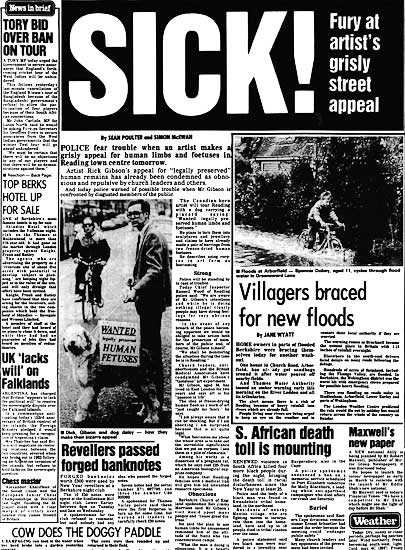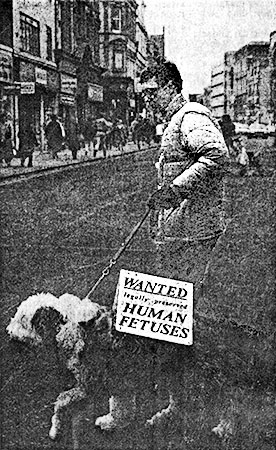The donation of the human foetuses at Cuts Gallery in London proved to me that advertising works. So for my first performance, I mobilized my ad campaign by sending this information to news reporters:
On Saturday, 4 January 1986, shoppers in central Reading, England will have a chance to see Daisy, an English sheep-dog, carrying a sandwich-board sign which reads: “Wanted: legally preserved human fetuses” and “Wanted: legally preserved human limbs.”
Accompanying her will be sculptor Rick Gibson. He wants to meet people who have legally preserved human organs and tissues to donate to him. All donated specimens will be freeze-dried and made into sculptures.
Included with the press release was this photo of Daisy and me:

It was soon featured on the front page of the Reading Evening Post newspaper:

Beneath the huge headline “SICK! Fury at Artist’s Grisly Street Appeal,” the first paragraph read:
POLICE fear trouble when an artist makes a grisly appeal for human limbs and foetuses in Reading town centre tomorrow.
Further along in the article, a spokesperson for the police was quoted as saying:
“We are aware of Mr Gibson’s intentions and while he is doing nothing illegal, clearly people may have strong feelings for obvious reasons.
“In the event of any disturbance of the peace, the police will take action both for the protection of members of the public, and of course, Mr Gibson.
“We shall be monitoring the situation during the time he is in Reading.”
The police were concerned because the newspaper also reported:
Church leaders, anti-abortionists and the British Medical Association have condemned Mr Gibson’s “tasteless” art experiment.
Berkshire Church of England spokesman Rev. Jimmy Morrison said Mr Gibson’s visit would upset many people and “cause great distress.”
He said the plan to use human limbs for amusement reminded him of the attitude of the Nazis who ran concentration camps.
“What the man is doing is obnoxious. It is a beastly practice,” he said.
A British Medical Association spokeswoman said: “It is certainly something at which we would register the strongest revulsion.”
Despite the concerns of the police and the criticisms of some people, I still went ahead with my plan because I was confident that my advertising campaign was legal.
And so, on the morning of the event, Daisy and I took a train from London to Reading where I put the sign on Daisy’s back and then we strolled into town.

Daisy’s lightweight sign had two sides. One side read, “WANTED: legally preserved HUMAN FETUSES” and the other side read, “WANTED: legally preserved HUMAN LIMBS.”

At one point during our walk, I talked to several people waiting to use a cash machine. All of them wanted to know what I was doing. I said that I wanted to meet people who had legally preserved human body parts that I could use to make sculptures.
Unfortunately, no one I met had any spare parts lying around the house. Nevertheless, I gave them my business card in case they found something later.
By the way, everyone I talked to that day was friendly and polite, so I was rather surprised when I later read this newspaper story:
Gibson’s appeal didn't impress mother-of-three Marion Buchan. "I hope someone punches him on the nose," she said. "If I stuffed your dog I wouldn't call that art.” Then she added, “I think he’s completely potty.”
The performance ended when Daisy and I took a train back to London.
© Rick Gibson